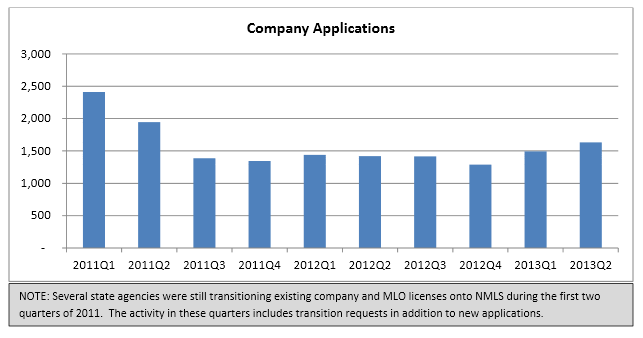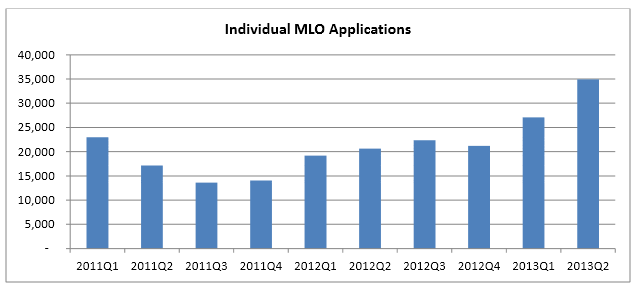The number of companies licensed through the National Mortgage Licensing System (NMLS) declined by 2.1 percent from the second quarter of 2012 to the second quarter of 2013 while the number of individuals licensed as loan originators (MLOs) increased by 8 percent. NMLS said that a total of 15,791 companies were licensed through the system at the end of the 2nd quarter along with 19,546 branch offices and 119,571 individuals. Companies reported employing an average of 6.7 loan officers.
An additional 10,669 institutions are registered as mortgage originators by one or more federal agencies, an annual decrease of 0.8 percent, as are 400,919 individuals, a number that is up 3.4 percent in a year. There is only a relatively small overlap between NMLS licenses and federal registration with 103 companies and 3,783 individuals holding dual status.
Among federally registered companies the largest number, 4,115 are registered through the Federal Deposit Insurance Corporation followed by the National Credit Union Administration with 3,972. The Office of the Comptroller of the Currency registers 1,728, the Federal Reserve 792, and 62 are registered with the Farm Credit Bureau.
Nationwide NMLS received 1,632 applications for new company licenses, 4,499 for branches, and 34,923 for individual licenses. Of those, 1,291 company applications were approved as were 3,929 for branch offices and 30,226 for MLOs.


A total of 16 companies and 55 loan officers had licenses revoked during the quarter and 2 companies and 24 MLOs were suspended.
The NMLS 2nd quarter report was virtually all tabular with no explanations for some of the anomalies such as an annual increase of 630 percent in company licenses held by one California licensing division and an 85 percent decrease in the other. It was notable, however, that the 18+ percent jump in company licenses in both North and South Dakota as well as the 83.6 percent increase in MLO licenses in the former and 63.0 percent increase in the latter appear to be verified by the number of applications for licenses in the two states and could reflect the energy industry fueled real estate boom in that part of the country.







